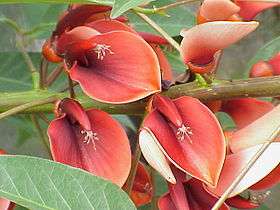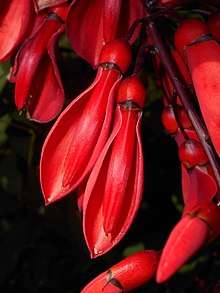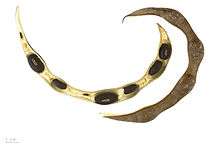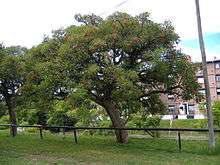Erythrina crista-galli
Erythrina crista-galli, often known as the cockspur coral tree, is a flowering tree in the family Fabaceae, native to Argentina, Uruguay, southern Brazil and Paraguay. It is widely planted as a street or garden tree in other countries, notably in California. It is known by several common names within South America: ceibo, seíbo (Spanish), corticeira (Portuguese) and the more ambiguous bucaré, to name a few. Its specific epithet crista-galli means "cock's comb" in Latin.
| Cockspur coral tree | |
|---|---|
 | |
| Flowers | |
| Scientific classification | |
| Kingdom: | |
| (unranked): | |
| (unranked): | |
| (unranked): | |
| Order: | |
| Family: | |
| Genus: | |
| Species: | E. crista-galli |
| Binomial name | |
| Erythrina crista-galli | |
| Synonyms | |
|
Many, see text | |
The ceibo is the national tree of Argentina, and its flower the national flower of Argentina and Uruguay.
This species characteristically grows wild in gallery forest ecosystems along watercourses, as well as in swamps and wetlands. In urban settings, it is often planted in parks for its bright red flowers.
Description
Erythrina crista-galli is a small tree, the girth of its trunk measuring 50 cm (20 in). Normally it grows 5–8 m (16–26 ft) tall, although some individuals, such as in the Argentine provinces of Salta, Jujuy and Tucumán, can grow up to 10 m (33 ft).
The root is a taproot with nodules produced by nitrogen-fixing bacteria. The bacteria live in symbiosis with the tree, facilitating the tree's absorption of nitrogen in return for organic substances which the bacteria need. The tree's trunk is woody with irregular, spiny branches. These branches form a layer without definite form[1] and die after flowering.

Flowers and fruit
The tree flowers in the summer, from October to April in their native South America and from April to October in the northern hemisphere. It usually blooms from November to February. The red flower, arranged in inflorescences of the raceme type, is pentameric, complete, and of bilateral symmetry. Its calyx is gamosepalous, like a little red thimble. The corolla, like that of other legumes like common beans, is butterfly-shaped; however, the largest petal, called the "standard", is arranged in the lower part. The two of the petals called "wings" are so small that they are practically hidden within the calyx. The remaining two petals partially fuse together on occasion and form the flower's keel or "carina"; this protects its reproductive organs. The androecium consists of ten stamens, one free and nine united by their filaments (gynostemial androecium). The unicarpel gynoecium is welded between the stamens like a knife in its sheath.
The flowers are rich in nectar and are visited by insects, which usually have to crawl underneath the carina and thus pollinate the flowers.

The tree's fruit is a legume, a dry pod a few centimeters in length derived from a single carpel and contains about 8-10 chestnut-brown bean-shaped seeds. The cotyledons are hypogeal, staying underground upon germination.
Cultivation
In cultivation in the United Kingdom this plant has gained the Royal Horticultural Society’s Award of Garden Merit.[2][3]
Synonyms
Synonyms are as follows:[4]
- Corallodendron crista-galli (L.) Kuntze
- Erythrina crista-galli L. var. hasskarlii Backer
- Erythrina crista-galli L. var. leucochlora Lombardo
- Erythrina fasciculata Benth.
- Erythrina laurifolia Jacq.
- Erythrina pulcherrima Tod.
- Erythrina speciosa Tod. (However, E. speciosa Andrews is a distinct species.)
- Micropteryx crista-galli Walp.
- Micropteryx fasciculata Walp.
- Micropteryx laurifolia Walp.
References
- This article draws heavily on the corresponding article in the Spanish-language Wikipedia.
- "Erythrina crista-galli (Cockspur Coral Tree)". Taranaki Educational Resource Research Analysis and Information Network. February 2015.
- "RHS Plantfinder - Eryhtrina crista-galli". Retrieved 16 February 2018.
- "AGM Plants - Ornamental" (PDF). Royal Horticultural Society. July 2017. p. 37. Retrieved 16 February 2018.
- International Legume Database & Information Service (ILDIS) (2005): Erythrina crista-galli. Version 10.01, November 2005. Retrieved 26 January 2008.
- Pink, Alfred (1904): Gardening for the Million. Fisher Unwin, London. TXT and HTML fulltexts at Project Gutenberg.
External links
| Wikimedia Commons has media related to: |
- John Stephen Glasby, Dictionary of Plants Containing Secondary Metabolites, Published by CRC Press
- Images of Legume, Seeds - Flavon's Wild herb and Alpine plants
- (in Spanish) Día de la Flor Nacional (National Flower Day) - from Argentina's Ministry of Health and Environment website (scientific description, pictures).

